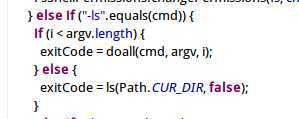标签:
Hadoop源码学习笔记(6)
——从ls命令一路解剖
Hadoop几个模块的程序我们大致有了点了解,现在我们得细看一下这个程序是如何处理命令的。 我们就从原头开始,然后一步步追查。
我们先选中ls命令,这是一个列出分面式文件系统中的目录结构。传入一个查阅地址,如果没有则是根目录。启动NameNode和DataNode服务。然后在命令行中输入ls :

换成程序,如果写呢,我们新建一个ClientEnter类。之前章节中,我们就知道,在命令行中输入的dfs命令,指向到org.apache.hadoop.fs.FsShell,则这个类入口是一个main函数。所以先直接用,在clientEnter类的main函数中加入下面代码:
FsShell.main(new String[]{"-ls"});
然后执行,看到下面结果:

这个结果,与控制台中的是一样的,所以说调用正确。注意,这里多加了几行初使化用的,先写上,后面会用。
动刀解剖,我们进入FsShell的main函数中,看看里面是怎么实现的:
-
public static void main(String argv[]) throws Exception {
-
FsShell shell = new FsShell();
-
int res;
-
try {
-
res = ToolRunner.run(shell, argv);
-
} finally {
-
shell.close();
-
}
-
System.exit(res);
-
}
它这里,通过ToolRunner绕了一下,目的是把argv进行了下处理,但最终回到了FsShell的run函数中,进之:

发现,里面有大量的if else 条件都是cmd判断是否等于某个命令,于是找到ls命令,发现其调了FsShell下的ls函数,进之:
-
private int ls(String srcf, boolean recursive) throws IOException {
-
Path srcPath = new Path(srcf);
-
FileSystem srcFs = srcPath.getFileSystem(this.getConf());
-
FileStatus[] srcs = srcFs.globStatus(srcPath);
-
if (srcs==null || srcs.length==0) {
-
throw new FileNotFoundException("Cannot access " + srcf +
-
": No such file or directory.");
-
}
-
-
boolean printHeader = (srcs.length == 1) ? true: false;
-
int numOfErrors = 0;
-
for(int i=0; i<srcs.length; i++) {
-
numOfErrors += ls(srcs[i], srcFs, recursive, printHeader);
-
}
-
return numOfErrors == 0 ? 0 : -1;
-
}
这个ls函数行数不多,容易看清,参数是第一个是文件路径,第二个是递归。
然后前2~4行,就可以看到,获取到了文件状态,第13行,是打印显示查到的文件状态结果。这里就不进入看了。
于是提到出2~4行代码,加入到我们的测试程序中。同时把之前的调用注释掉:
-
// 列出文件(原)
-
//FsShell.main(new String[]{"-ls"});
-
FileSystem srcFs = FileSystem.get(conf);
-
FileStatus[] items = srcFs.listStatus(new Path("hdfs://localhost:9000/user/zjf"));
-
for (int i = 0; i < items.length; i++)
-
System.out.println( items[i].getPath().toUri().getPath());
小步快走,运行之,发现文件夹是对的,但打印内容少了,没错,因为我们没从FileStatus中全打出来。
这里可以看到,ls命令的核心是FileSystem中的listStatus函数了。
继续动刀。
观察FileSystem的listStatus函数,发现是个虚函数,同时FileSystem也是个一个抽象类,说明具体的listStatus实现,必然还在其它类中。于是监视srcFs类,发现其类型为DistributedFileSystem于是,把代码转换一下:
DistributedFileSystem srcFs = (DistributedFileSystem)FileSystem.get(conf);
运行程序,没有变化。说明路走对了。
继续,想抛弃这个FileSystem类呢,就行看看它如何在get方法中创建DistributedFileSystem这个类的,一级级查,发现,最终是在这里创建:
-
private static FileSystem createFileSystem(URI uri, Configuration conf ) throws IOException {
-
Class<?> clazz = conf.getClass("fs." + uri.getScheme() + ".impl", null);
-
if (clazz == null) {
-
throw new IOException("No FileSystem for scheme: " + uri.getScheme());
-
}
-
FileSystem fs = (FileSystem)ReflectionUtils.newInstance(clazz, conf);
-
fs.initialize(uri, conf);
-
return fs;
-
}
这里应用了反射,可以看出,作者还是很牛的,这函数跟据传入的uri,的scheme(就是地址的前缀),来根据配置,创建相应的实现类,是一个工厂模式。
这里我们传入的uri是hdfs:// 所以查询参数:fs.hadfs.impl。于是到core-default.xml中查:
-
<property>
-
<name>fs.hdfs.impl</name>
-
<value>org.apache.hadoop.hdfs.DistributedFileSystem</value>
-
<description>The FileSystem for hdfs: uris.</description>
-
</property>
发现,此处配置文件,正是我们的DistributeFileSystem类。
然后看到,创建对象完后,就调用了initialize函数。于是我们把程序进一步改造:
-
DistributedFileSystem srcFs = new DistributedFileSystem();
-
srcFs.initialize(uri, conf);
-
FileStatus[] items = srcFs.listStatus(new Path(
-
......
运行程序,保持正确结果。
此时,可以杀入DistributedFileSystem类的listStatus函数了。
-
public FileStatus[] listStatus(Path p) throws IOException {
-
FileStatus[] infos = dfs.listPaths(getPathName(p));
-
if (infos == null) return null;
-
FileStatus[] stats = new FileStatus[infos.length];
-
for (int i = 0; i < infos.length; i++) {
-
stats[i] = makeQualified(infos[i]);
-
}
-
return stats;
-
}
进入后,发现主要由这个dfs对象访问,于是寻找dfs对象的创建:
this.dfs = new DFSClient(namenode, conf, statistics);
于是继续把我们的程序改造:
-
Statistics statistics = new Statistics(uri.getScheme());
-
InetSocketAddress namenode = NameNode.getAddress(uri.getAuthority());
-
DFSClient dfs = new DFSClient(namenode, conf, statistics);
-
FileStatus[] items = dfs.listPaths("/user/zjf");
-
for (int i = 0; i < items.length; i++)
-
System.out.println(items[i].getPath().toUri().getPath());
改造后,运行,结果与之前相同,说明路走对了。
继续前进,进入listPath函数,发现又是调用了ClientProtocol类的getListing函数。而这个ClientProtocol接口,好象有点熟悉了,在之前讲RPC调用时,这个是一个给客户端使用的接口,而具体的实现,在服务器端。
所以抛开DFSClient类,我们自己也可以创建这个RPC接口,然后自己调用。改造成如下:
-
InetSocketAddress nameNodeAddr = NameNode.getAddress(uri.getAuthority());
-
ClientProtocol namenode = (ClientProtocol)RPC.getProxy(ClientProtocol.class,
-
ClientProtocol.versionID, nameNodeAddr, UnixUserGroupInformation.login(conf, true), conf,
-
NetUtils.getSocketFactory(conf, ClientProtocol.class));
-
FileStatus[] items = namenode.getListing("/user/zjf");
-
for (int i = 0; i < items.length; i++)
-
System.out.println(items[i].getPath().toUri().getPath());
此时,我们在Client这端已经走到了尽头,RPC调用getListing接口,具体实现是在nameNode服务器端了。
即然RPC在客户端调用的接口,具体是在服务器端实现。那么,我们如果直接创建服务器端的实现类,调用相应类的函数,不也能产出相同的结果么。
于是直接使用NameNode来创建实例,来调用:
-
UserGroupInformation.setCurrentUser(UnixUserGroupInformation.login(conf, true));
-
NameNode namenode = new NameNode(conf);
-
FileStatus[] items = namenode.getListing("/user/zjf");
-
for (int i = 0; i < items.length; i++)
-
System.out.println(items[i].getPath().toUri().getPath());
运行该程序时,需要把之前的NameNode程序停止掉,因为我们不再需要这个服务,而是直接call这个服务中的方法了。
到目前为止,我们已经通过ls这个命令,从client端一杀到了namenode端。然后分析其它几个命令(delete,mkdir,getFileInfo)与ls相同。所以要想再深入看这些命令的处理,得在namenode中进一步研究。
namenode我们知道,主要存放的是文件目录信息,那利用上述这些命令,就可以进一步研究其目录的存储方式。这一块将在下一章中为进一步探讨。
Hadoop源码学习笔记(6)——从ls命令一路解剖
标签:
原文地址:http://www.cnblogs.com/zjfstudio/p/4222400.html


